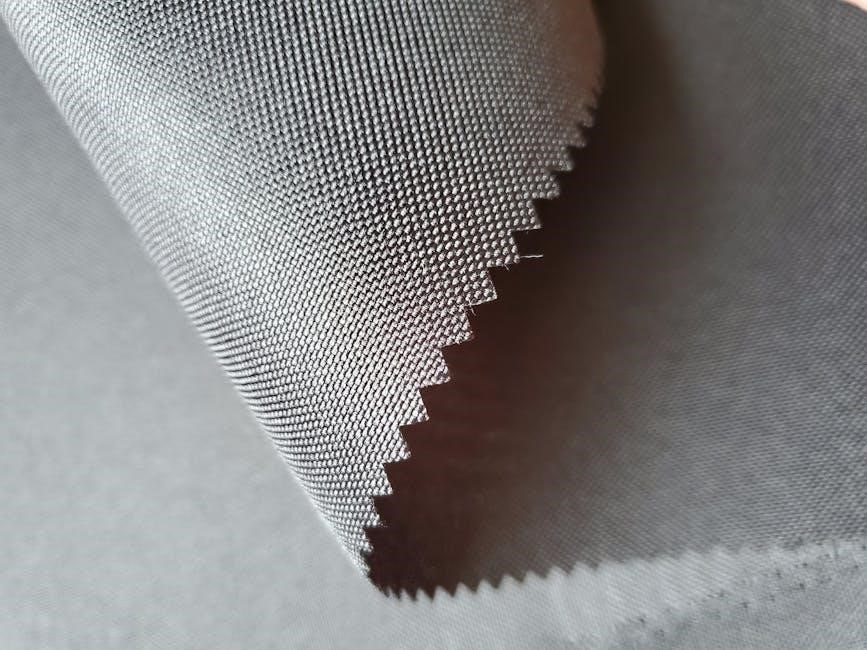
catia composite design pdf
CATIA V5 Composites Design enables engineers to create lightweight, high-performance composite parts․ This 5-day course covers defining laminates, manufacturing preparation, and design best practices, essential for modern engineering․
Composite materials are critical in industries like aerospace and automotive, offering weight reduction and structural integrity․ CATIA V5 provides tools for designing and preparing laminated parts for production․
Resources like PDF guides and courses (e․g․, EDU-CAT-en-CPD-F) are available, detailing composites design and manufacturing․ These materials help engineers master CATIA V5 for complex composite structures․
1․1․ Overview of CATIA V5 Composites Design
CATIA V5 Composites Design offers a comprehensive solution for creating lightweight, high-performance composite parts․ The 5-day course covers defining laminates, manufacturing preparation, and design best practices, essential for modern engineering․
It focuses on engineering design topics like laminates, manufacturing constraints, and production-ready designs․ Resources include PDF guides, courses (e․g․, EDU-CAT-en-CPD-F), and tutorials, providing in-depth knowledge for mastering composite design in CATIA V5․
These tools enable engineers to design complex composite structures efficiently, catering to industries like aerospace and automotive, where weight reduction and structural integrity are critical․
1․2․ Importance of Composite Materials in Modern Engineering
Composite materials are vital in modern engineering due to their high strength-to-weight ratio, corrosion resistance, and versatility․ They enable lightweight designs, reducing fuel consumption in aerospace and automotive industries․
CATIA V5 Composites Design PDF resources highlight their significance in creating high-performance parts․ These materials are essential for applications requiring durability and minimal weight, driving innovation across various sectors․
Engineers rely on composites to meet structural integrity demands while optimizing material efficiency, making them indispensable in contemporary engineering projects․

Key Concepts in Composite Design
Composite design involves understanding laminates, layers, and material selection․ It requires knowledge of manufacturing processes and structural analysis to optimize performance and durability in modern engineering applications․
2․1․ Understanding Laminates and Layers in Composites
Laminates are composite materials made from multiple layers of reinforcement, such as carbon or glass fibers, bonded together with a polymer matrix․ Each layer, or ply, contributes to the overall strength and stiffness of the composite part․ In CATIA V5, engineers can define laminates by specifying the sequence of layers, their orientations, and materials․ This allows for precise control over the structural properties of the composite, ensuring optimal performance under various loads․ Proper laminate design is critical for achieving the desired weight reduction and structural integrity in modern engineering applications․
2․2․ Material Selection for Composite Structures
Material selection is critical in composite design, balancing weight, strength, and cost․ Common materials include carbon, glass, and aramid fibers, combined with polymer matrices․ CATIA V5 enables engineers to define and analyze these materials, ensuring optimal performance․ Factors like environmental conditions, load requirements, and manufacturing constraints guide the selection process․ The software provides libraries of materials and tools to simulate their behavior․ Proper material selection ensures lightweight, durable, and cost-effective composite structures, meeting industry standards and application demands․ This step is vital for achieving structural integrity and performance in aerospace, automotive, and other industries․
2․3․ Basic Principles of Composite Manufacturing
Composite manufacturing involves combining reinforcement materials, like fibers, with a matrix, typically resin․ Key methods include hand layup, vacuum bagging, and resin transfer molding․ Each process requires precise control of pressure, temperature, and curing times․ Proper fiber alignment and minimal voids ensure structural integrity․ Challenges include avoiding defects like air bubbles and ensuring even resin distribution․ Skilled labor and advanced tools are essential for achieving high-quality results․ Understanding these principles is fundamental for designing and producing durable, lightweight composite components in various industries․
CATIA V5 Composites Part Design
CATIA V5 Composites Part Design enables engineers to create lightweight, high-performance components․ It offers advanced tools for defining laminates and simulating fiber orientations, ensuring precise results․
3․1․ Defining Laminates in CATIA V5
Defining laminates in CATIA V5 involves creating layered composite structures with precise material orientation․ Engineers use the Laminate Design workbench to define stacking sequences, ply thickness, and fiber angles․ This process ensures optimal material properties for strength and weight reduction․ CATIA V5 allows for the creation of complex laminates, enabling users to simulate and analyze their behavior under various loads․ The software also supports the import of material data, streamlining the design-to-manufacturing workflow․ Accurate laminate definition is critical for achieving desired performance in composite parts․
3․2․ Creating Composite Parts Using CATIA Tools
CATIA V5 provides advanced tools for creating composite parts, enabling engineers to design and analyze complex structures․ The Composite Design workbench offers features for ply creation, fiber orientation, and laminate stacking․ Users can define materials, thicknesses, and angles to optimize performance․ CATIA’s tools also support the creation of draping simulations and fiber orientation analysis․ These capabilities ensure accurate representation of composite behavior, aiding in the development of lightweight and durable components․ The software integrates seamlessly with other modules, streamlining the composite part design process․
3․3․ Best Practices for Designing Composite Parts
When designing composite parts in CATIA, follow best practices to ensure optimal results․ Start with material selection, considering factors like strength, weight, and cost․ Use symmetric laminates to minimize warping and ensure balanced structures․ Define fiber orientations carefully to maximize mechanical properties․ Regularly test and validate designs using simulation tools․ Document all design steps and material properties for traceability․ Collaborate with manufacturing teams early to address production feasibility․ Finally, leverage CATIA’s automation features to streamline repetitive tasks and maintain design consistency across projects․

Manufacturing Preparation in CATIA
Ensure designs meet production requirements by defining manufacturing constraints and generating production-ready files․ Utilize CATIA tools to validate feasibility and optimize for assembly processes efficiently․
4․1․ Preparing Composite Parts for Production
Preparing composite parts for production involves ensuring manufacturability, material accuracy, and design integrity․ Verify laminate structures, fiber orientations, and ply counts․ Check for production-friendly geometries and proper material assignments․ Use CATIA tools to simulate draping, detect wrinkles, and optimize fiber placement․ Export data in formats compatible with CNC machines or automated fiber placement systems․ Incorporate assembly features and tolerances to align with production standards․ Ensure all design parameters meet quality control benchmarks for seamless manufacturing processes․ This step ensures designs are production-ready and meet industry specifications effectively․
4․2․ Understanding Manufacturing Constraints in CATIA
Manufacturing constraints in CATIA ensure designs align with production capabilities․ Factors like material limits, machine tolerances, and process-specific requirements are critical․ CATIA tools help identify and address constraints early, optimizing designs for producibility․ For composites, constraints may include fiber orientation, drapability, and tooling limitations․ By understanding these, designers can create realistic and manufacturable parts, reducing production errors and costs․ Proper constraint management enhances collaboration between design and manufacturing teams, ensuring smooth transitions from concept to production․
4․3․ Generating Production-Ready Designs
Generating production-ready designs in CATIA involves finalizing composite structures for manufacturing․ This step ensures designs meet technical and production standards․ Tools within CATIA enable verification of manufacturability, material specifications, and dimensional accuracy․ Designers can export detailed drawings, BOMs, and data files for production teams․ This process streamlines communication and ensures seamless transitions to manufacturing․ Production-ready designs minimize errors and delays, optimizing the production workflow․ Proper documentation and adherence to industry standards are critical for successful implementation․

Advanced Features in CATIA Composites Design
CATIA Composites Design offers advanced features for complex structures, including automation, simulation, and integration with other tools, enhancing precision and efficiency in composite material modeling․
5․1․ Using CATIA V5 for Complex Composite Structures
CATIA V5 excels in designing intricate composite structures by offering advanced tools for precise material modeling and simulation․ Its intuitive interface allows engineers to create complex laminates, optimize fiber orientations, and analyze stress distributions․ The software supports multi-material designs, enabling the integration of composites with metals and other materials seamlessly․ Advanced simulation capabilities ensure structural integrity and performance under various loads․ These features make CATIA V5 indispensable for industries requiring lightweight, high-strength components, such as aerospace and automotive․ Its versatility streamlines the design process, reducing errors and enhancing production efficiency․
5․2․ Advanced Laminate Design Techniques
CATIA V5 offers sophisticated tools for creating complex laminates, enabling precise ply-based modeling and optimization․ Engineers can design balanced, symmetric laminates and manage ply drops effectively․ The software supports advanced fiber orientation optimization, ensuring maximum strength and stiffness․ Additionally, it allows for the creation of variable thickness laminates and integration of core materials․ These techniques enhance mechanical performance while minimizing weight․ The Generative Shape Design workbench further aids in creating complex geometries․ Advanced laminate design in CATIA V5 streamlines the development of high-performance composite structures, ensuring optimal material usage and structural integrity․
5․3․ Integration with Other CATIA Modules
CATIA V5 enables seamless integration with other modules, enhancing the composite design process․ Engineers can leverage tools from the Part Design, Surface Design, and Assembly Design workbenches to create complex geometries․ The software also integrates with CATIA’s Simulation module, allowing for structural analysis and optimization of composite laminates․ Additionally, the Manufacturing Workbench ensures designs are production-ready, supporting CNC machining and tooling design․ This interdisciplinary approach streamlines workflows, enabling teams to collaborate effectively and deliver high-quality composite products tailored to industry standards and requirements․
Training and Resources
CATIA V5 composite design training is supported by official courses, tutorials, and PDF guides․ Dassault Systèmes offers comprehensive resources to master composite modeling, analysis, and manufacturing techniques․
6․1․ CATIA V5 Composites Design Courses
CATIA V5 composites design courses are tailored for engineers to master advanced composite modeling and analysis․ These courses cover laminate creation, material selection, and manufacturing preparation․ Official CATIA trainers provide hands-on sessions, ensuring practical expertise․ The curriculum includes real-world projects, enabling learners to apply concepts effectively․ Additionally, participants gain access to PDF resources, such as detailed guides and reference materials, to enhance their learning experience․ These courses are ideal for professionals aiming to excel in composite design and manufacturing using CATIA V5․
6․2․ Tutorials and Guides for Composite Design
Tutorials and guides for CATIA composite design provide step-by-step instructions for mastering composite modeling․ Official Dassault Systèmes resources include interactive tutorials and PDF guides․ These materials cover laminate design, material selection, and manufacturing preparation․ Video tutorials offer practical demonstrations, while written guides provide in-depth explanations․ Engineers can access these resources to improve their skills in creating lightweight, durable composite structures․ Additionally, tips for optimizing workflows and troubleshooting common issues are included, making these guides indispensable for both beginners and experienced professionals․
6․3․ Accessing CATIA Composite Design PDF Resources
Accessing CATIA composite design PDF resources is straightforward through official channels and trusted platforms․ The Dassault Systèmes website offers downloadable PDF guides, including tutorials and reference materials․ Third-party sites like Scribd or ResearchGate may also host relevant PDF resources․ Ensure authenticity by verifying the source․ These PDFs often include detailed workflows, best practices, and troubleshooting tips․ They are invaluable for engineers seeking to enhance their skills in composite design․ Regularly updated resources ensure users stay current with the latest tools and methodologies․

Real-World Applications
CATIA composite design is widely used in aerospace, automotive, and sports equipment industries for creating lightweight, durable structures․ Its applications include aircraft wings, car chassis, and marine components․
7․1․ Aerospace Industry Applications
CATIA composite design is pivotal in aerospace engineering, enabling the creation of lightweight, high-strength components․ It is used for designing aircraft wings, fuselage panels, and engine components․ The software allows engineers to optimize laminate structures for minimal weight while maintaining structural integrity․ Aerospace manufacturers rely on CATIA for precise fiber orientation and material selection, ensuring compliance with strict industry standards․ Its capabilities in simulating manufacturing processes also aid in producing complex composite parts efficiently, making it indispensable for modern aircraft development․
7․2․ Automotive Industry Applications
CATIA composite design plays a significant role in the automotive industry by enabling the creation of lightweight, durable components․ It is widely used for designing vehicle bodies, chassis parts, and interior components․ The software aids in reducing vehicle weight, enhancing fuel efficiency, and improving performance․ Automotive manufacturers leverage CATIA to design composite materials for electric vehicle (EV) components, such as battery enclosures and structural frames․ Its advanced tools also support rapid prototyping and simulation, ensuring cost-effective and high-performance composite solutions for modern vehicles․
7․3․ Other Industries Using Composite Design
Beyond aerospace and automotive, CATIA composite design is utilized in various industries․ Sports equipment manufacturers use it to create lightweight, high-performance products like bicycles and skis․ The energy sector employs composites for wind turbine blades and offshore equipment․ Healthcare also benefits, with CATIA aiding in the design of custom prosthetics and medical devices․ Additionally, consumer goods and marine industries leverage CATIA for innovative, durable, and cost-effective composite solutions, showcasing its versatility across diverse sectors․
Design Considerations and Challenges
Designing composites in CATIA requires balancing weight reduction, structural integrity, and material costs․ Challenges include optimizing material efficiency, managing manufacturing complexities, and addressing design limitations effectively․
8․1․ Weight Reduction and Structural Integrity
In CATIA composite design, achieving weight reduction while maintaining structural integrity is critical․ Composite materials offer exceptional strength-to-weight ratios, enabling lightweight yet durable structures․ CATIA’s advanced tools allow engineers to optimize material distribution, ensuring minimal weight without compromising performance․ Finite element analysis (FEA) and multiscale analysis are used to validate structural integrity under various loads․ This balance is crucial for aerospace and automotive applications, where every gram saved enhances efficiency․ By leveraging CATIA’s capabilities, designers can create components that meet both weight and strength requirements effectively․

8․2․ Cost and Material Efficiency
Cost and material efficiency are vital in CATIA composite design, as composites are often more expensive than traditional materials․ CATIA’s tools enable precise material optimization, reducing waste and minimizing costs․ Finite element analysis (FEA) helps identify areas where material can be reduced without compromising strength․ Generative design further supports cost efficiency by creating lightweight, complex geometries․ By optimizing material usage and reducing scrap, CATIA helps lower production costs while maintaining performance․ This ensures composite parts are both cost-effective and high-quality, making them viable for various industries․

8․3; Overcoming Design Limitations in CATIA
Overcoming design limitations in CATIA composite design involves leveraging advanced tools and techniques․ Challenges like complex geometries and material behavior can be addressed using CATIA’s simulation and analysis capabilities․ The Composite Design Workbench offers features to refine laminates and optimize structures․ Collaboration across teams and modules ensures seamless integration․ By iterating on designs and utilizing CATIA’s robust simulation tools, engineers can overcome constraints and achieve optimal results․ This approach ensures designs meet both functional and manufacturing requirements, enhancing overall efficiency and innovation in composite design projects․

Tools and Workbenches in CATIA
CATIA offers specialized tools like the Composite Design Workbench, enabling precise laminate creation and analysis․ The Part Design and Assembly Design workbenches further enhance composite part development and integration․
9․1․ Composite Design Workbench

The Composite Design Workbench in CATIA V5 is a dedicated tool for creating and managing composite structures․ It offers a user-friendly interface for defining laminates, plies, and stacking sequences․ Designers can easily import material properties and perform structural analyses․ The workbench supports ply-based design, allowing for precise control over fiber orientation and thickness․ It also integrates with other CATIA modules, ensuring seamless collaboration between design and manufacturing teams․ This tool is essential for optimizing composite parts, enhancing performance, and reducing production costs;
9․2․ Laminate Design Tools
The Laminate Design Tools in CATIA V5 enable precise creation and modification of composite laminates․ Designers can define ply orientations, thicknesses, and material properties with accuracy․ The tools support the simulation of laminate behavior under various loads, ensuring optimal performance․ Features like ply-based design and automated ply generation streamline the process․ Additionally, the tools allow for the analysis of laminate draping effects and material utilization․ These capabilities enhance the efficiency and accuracy of composite design, making them indispensable for engineers working with advanced materials․
9․3․ Manufacturing Simulation Tools
CATIA V5 offers advanced manufacturing simulation tools to optimize composite part production․ These tools enable engineers to model and analyze draping simulations, predicting material behavior during forming․ Additionally, they simulate curing processes and residual stresses, ensuring parts meet specifications․ The tools provide insights into potential manufacturing defects, allowing for design adjustments․ By integrating with other CATIA modules, they enhance production planning and reduce errors․ These simulations are crucial for achieving high-quality composite parts efficiently․
CATIA V5 continues to evolve, offering enhanced tools for composite design․ Future trends include AI integration, sustainability-focused materials, and streamlined workflows, driving innovation in composite manufacturing․

10․1․ The Future of Composite Design in CATIA
CATIA V5 is poised to revolutionize composite design with AI-driven tools, enhancing material efficiency and structural analysis․ Future updates will focus on real-time simulation, sustainability, and integration with emerging technologies like machine learning․ As industries demand lightweight, high-performance materials, CATIA will streamline workflows, enabling faster production of complex composite structures․ The platform will also prioritize eco-friendly practices, offering solutions for recycling and reducing waste․ These advancements will solidify CATIA’s role as a leader in composite design, driving innovation across aerospace, automotive, and beyond․
10․2․ Emerging Technologies in Composite Manufacturing
Emerging technologies like 3D printing and automation are transforming composite manufacturing, enabling faster production of complex geometries․ Advanced material modeling and simulation tools in CATIA V5 are optimizing laminate design and reducing prototyping time․ The integration of AI for predictive analytics and real-time process monitoring is enhancing manufacturing precision․ Additionally, sustainable practices, such as recycling carbon fiber, are gaining traction, aligning with global environmental goals․ These innovations are reshaping the future of composite manufacturing, making it more efficient and eco-friendly․
10․3․ Final Thoughts on CATIA Composite Design
CATIA V5 remains an essential tool for composite design, offering unparalleled precision and flexibility․ Its advanced features streamline workflows, from concept to production, enabling engineers to create lightweight, durable structures․ By leveraging CATIA’s capabilities, professionals can optimize material usage, reduce costs, and meet stringent industry standards․ As composites continue to dominate modern engineering, mastering CATIA V5 is crucial for staying competitive․ With continuous updates and growing resources like PDF guides, CATIA ensures users are equipped to innovate and excel in composite design․
